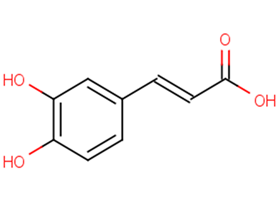
Caffeic Acid
CAS No. 331-39-5
Caffeic Acid( —— )
Catalog No. M18430 CAS No. 331-39-5
Caffeic Acid is an orally bioavailable, hydroxycinnamic acid derivative and polyphenol, with potential anti-oxidant, anti-inflammatory, and antineoplastic activities.
Purity : >98% (HPLC)
 COA
COA
 Datasheet
Datasheet
 HNMR
HNMR
 HPLC
HPLC
 MSDS
MSDS
 Handing Instructions
Handing Instructions
| Size | Price / USD | Stock | Quantity |
| 50MG | 30 | Get Quote |


|
| 100MG | 42 | Get Quote |


|
| 200MG | Get Quote | Get Quote |


|
| 500MG | Get Quote | Get Quote |


|
| 1G | Get Quote | Get Quote |


|
Biological Information
-
Product NameCaffeic Acid
-
NoteResearch use only, not for human use.
-
Brief DescriptionCaffeic Acid is an orally bioavailable, hydroxycinnamic acid derivative and polyphenol, with potential anti-oxidant, anti-inflammatory, and antineoplastic activities.
-
DescriptionCaffeic Acid is an orally bioavailable, hydroxycinnamic acid derivative and polyphenol, with potential anti-oxidant, anti-inflammatory, and antineoplastic activities.
-
In Vitro——
-
In Vivo——
-
Synonyms——
-
PathwayMAPK/ERK Signaling
-
TargetJNK
-
RecptorOthers
-
Research AreaOthers-Field
-
Indication——
Chemical Information
-
CAS Number331-39-5
-
Formula Weight180.16
-
Molecular FormulaC9H8O4
-
Purity>98% (HPLC)
-
SolubilityDMSO : 106.7 mg/mL 592.25 mM
-
SMILESc1cc(c(cc1/C=C/C(=O)O)O)O
-
Chemical Name——
Shipping & Storage Information
-
Storage(-20℃)
-
ShippingWith Ice Pack
-
Stability≥ 2 years
Reference
1. Pradhananga S, Shim WS. Eur J Pharmacol. 2015 Sep 5;762:313-21.
molnova catalog



related products
-
c-JUN peptide
Peptide comprising residues 33 - 57 of the JNK binding (δ) domain of human c-Jun. Disrupts JNK/c-Jun interaction leading to inhibition of serum-induced c-Jun phosphorylation, up-regulation of p21cip/waf and modulation of inflammatory gene expression. Specifically induces apoptosis in HeLa tumor cells.
-
GSK2879552 2HCl
GSK2879552 is an orally available, irreversible inhibitor of lysine specific demethylase 1 (LSD1), with potential antineoplastic activity.
-
GNE-617
GNE-617, a specific NAMPT inhibitor(IC50=5 nM), shows potency in xenograft models of cancer.



 Cart
Cart
 sales@molnova.com
sales@molnova.com


